Related Research Articles

Harriet Elisabeth Beecher Stowe was an American author and abolitionist. She came from the religious Beecher family and wrote the popular novel Uncle Tom's Cabin (1852), which depicts the harsh conditions experienced by enslaved African Americans. The book reached an audience of millions as a novel and play, and became influential in the United States and in Great Britain, energizing anti-slavery forces in the American North, while provoking widespread anger in the South. Stowe wrote 30 books, including novels, three travel memoirs, and collections of articles and letters. She was influential both for her writings as well as for her public stances and debates on social issues of the day.

The Pearl incident was the largest recorded nonviolent escape attempt by enslaved people in United States history. On April 15, 1848, seventy-seven slaves attempted to escape Washington D.C. by sailing away on a schooner called The Pearl. Their plan was to sail south on the Potomac River, then north up the Chesapeake Bay and Delaware River to the free state of New Jersey, a distance of nearly 225 miles (362 km). The attempt was organized by both abolitionist whites and free blacks, who expanded the plan to include many more enslaved people. Paul Jennings, a former slave who had served President James Madison, helped plan the escape.

The internal slave trade in the United States, also known as the domestic slave trade, the Second Middle Passage and the interregional slave trade, was the mercantile trade of enslaved people within the United States. It was most significant after 1808, when the importation of slaves from Africa was prohibited by federal law. Historians estimate that upwards of one million slaves were forcibly relocated from the Upper South, places like Maryland, Virginia, Kentucky, North Carolina, Tennessee, and Missouri, to the territories and then-new states of the Deep South, especially Georgia, Alabama, Louisiana, Mississippi, and Arkansas.
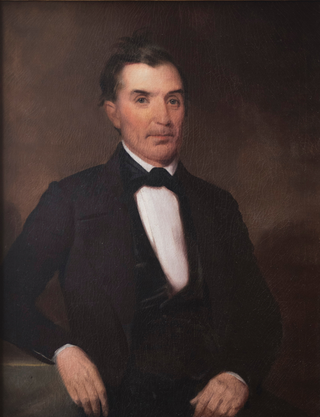
Isaac Franklin was an American slave trader and plantation owner. Born to wealthy planters in what would become Sumner County, Tennessee, he assisted his brothers in trading slaves and agricultural surplus along the Mississippi River in his youth, before briefly serving in the Tennessee militia during the War of 1812. He returned to slave trading soon after the war, buying enslaved people in Virginia and Maryland, before marching them in coffles to sale at Natchez, Mississippi. He introduced John Armfield to the slave trade, and with him founded the Franklin & Armfield partnership in 1828, which would go on to become one of the largest slave trading firms in the United States. With a base of operations in Alexandria, D.C., the company shipped massive numbers of the enslaved by land and sea to markets at Natchez and New Orleans.

The Franklin and Armfield Office, which houses the Freedom House Museum, is a historic commercial building in Alexandria, Virginia. Built c. 1810–1820, it was first used as a private residence before being converted to the offices of the largest slave trading firm in the United States, started in 1828 by Isaac Franklin and John Armfield. Another source, using ship manifests in the National Archives, gives the number as "at least 5,000".

Calvin Ellis Stowe was an American Biblical scholar who helped spread public education in the United States. Over his career, he was a professor of languages and Biblical and sacred literature at Andover Theological Seminary, Dartmouth College, Lane Theological Seminary, and Bowdoin College. He was the husband and literary agent of Harriet Beecher Stowe, author of the best-seller Uncle Tom's Cabin.
Austin Woolfolk (1796–1847) was an American slave trader. Among the busiest slave traders in Maryland, he trafficked more than 2,000 enslaved people through the port of Baltimore to the port of New Orleans, and became notorious in time for selling Frederick Douglass's aunt, and for assaulting Benjamin Lundy after the latter had criticized him.

The Forks of the Road was a slave market in Natchez, Mississippi in the United States. The Forks of the Road market was located about a mile from downtown Natchez at the intersection of the ironically named Liberty Road and Washington Road, which has since been renamed to D'Evereux Drive in one direction and St. Catherine Street in the other. The market differed from many other slave sellers of the day by offering individuals on a first-come first-serve basis rather than selling them at auction, either singly or in lots. At one time the Forks of the Road was the second-largest slave market in the United States, trailing only New Orleans.

This is a bibliography of works regarding the internal or domestic slave trade in the United States (1775–1865, with a measurable increase in activity after 1808, following the Act Prohibiting Importation of Slaves).
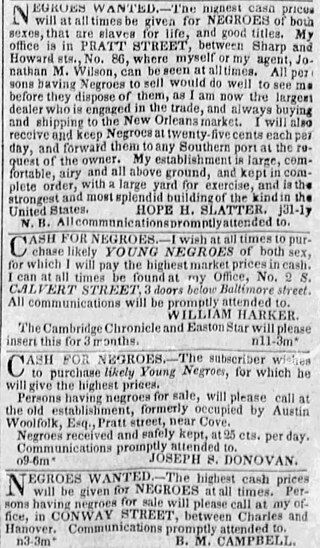
Bernard Moore Campbell and Walter L. Campbell operated an extensive slave-trading business in the antebellum U.S. South. B. M. Campbell, in company with Austin Woolfolk, Joseph S. Donovan, and Hope H. Slatter, has been described as one of the "tycoons of the slave trade" in the Upper South, "responsible for the forced departures of approximately 9000 captives from Baltimore to New Orleans." Bernard and Walter were brothers.
Fugitive slave advertisements in the United States, or runaway slave ads, were paid classified advertisements describing a missing person and usually offering a monetary reward for the recovery of the valuable chattel. Fugitive slave ads were a unique vernacular genre of non-fiction specific to the antebellum United States. These ads often include detailed biographical information about individual enslaved Americans including "physical and distinctive features, literacy level, specialized skills," and "if they might have been headed for another plantation where they had family, or if they took their children with them when they ran."

Slave markets and slave jails in the United States were places used for the slave trade in the United States from the founding in 1776 until the total abolition of slavery in 1865. Slave pens, also known as slave jails, were used to temporarily hold enslaved people until they were sold, or to hold fugitive slaves, and sometimes even to "board" slaves while traveling. Slave markets were any place where sellers and buyers gathered to make deals. Some of these buildings had dedicated slave jails, others were negro marts to showcase the slaves offered for sale, and still others were general auction or market houses where a wide variety of business was conducted, of which "negro trading" was just one part.

Theophilus Freeman was a 19th-century American slave trader of Virginia, Louisiana and Mississippi. He was known in his own time as wealthy and problematic. Freeman's business practices were described in two antebellum American slave narratives—that of John Brown and that of Solomon Northup—and he appears as a character in both filmed dramatizations of Northrup's Twelve Years a Slave.
Rice Carter Ballard was a 19th-century American slave trader, plantation owner, and cotton merchant. His slave trading partners were Isaac Franklin and John Armfield. After leaving the slave-trading business, Ballard invested his profits in land and enslaved people. Together Ballard and his investment partner Samuel S. Boyd owned about 500 people in 1860. The University of North Carolina holds an archive of Ballard's correspondence and business that has been uploaded to FromthePage.com, a crowdsourced transcription platform.

Seth Woodroof was a slave trader based in Lynchburg in central Virginia, United States. He was an interstate trader who ran what the Lynchburg Museum called the "most active and infamous" slave pen in the city. He is believed to have been actively trading from approximately 1830 until the beginning of the American Civil War in 1861. Woodroof sat on the Lynchburg city council from 1858 to 1865.
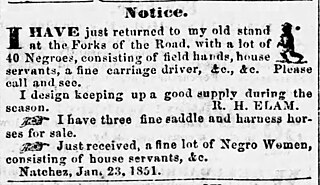
Robert H. Elam, usually advertising as R. H. Elam, was an American interstate slave trader who worked in Tennessee, Kentucky, Louisiana, and Mississippi.
Uncas was one of three brigs used as slave ships that were owned by the American slave-trading firm Franklin & Armfield. Uncas was built in Connecticut in 1833 and weighed 155 tons. The two-masted brig cost US$7,250.
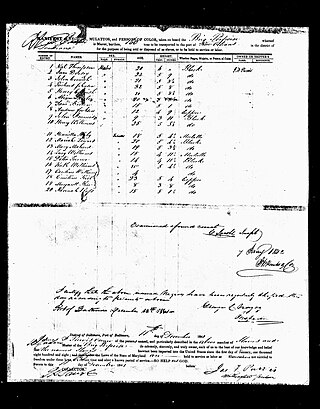
James Franklin Purvis was an American slave trader, broker, and banker who worked primarily in Baltimore. He was a nephew of Isaac Franklin of Franklin & Armfield, and traded in Maryland, Louisiana, and Mississippi in the 1830s and early 1840s. In 1842 he became a devout Methodist, quit the slave trade, and transitioned into real estate, banking, and stock brokering. After his bank failed in 1868, he retired to Carroll County, Maryland, where he died of a heart attack in 1880 at age 72.
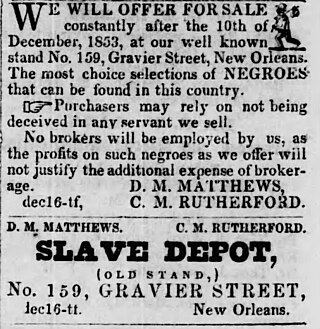
Calvin Morgan Rutherford, generally known as C. M. Rutherford, was a 19th-century American interstate slave trader. Rutherford had a wide geographic reach, trading nationwide from the Old Dominion of Virginia to as far west as Texas. Rutherford had ties to former Franklin & Armfield associates, worked in Kentucky for several years, advertised to markets throughout Louisiana and Mississippi, and was a major figure in the New Orleans slave trade for at least 20 years. Rutherford also invested his money in steamboats and hotels.
References
- ↑ "Special Report: Richmond's Slave Trade (Part 2 of 4)". Richmond Times-Dispatch. 2014-02-23. pp. A10. Retrieved 2023-08-14.
- ↑ "Image 174 of Federal Writers' Project: Slave Narrative Project, Vol. 5, Indiana, Arnold-Woodson". Library of Congress, Washington, D.C. 20540 USA. Retrieved 2023-12-27.
- ↑ Kolchin, Peter (1983). "Reevaluating the Antebellum Slave Community: A Comparative Perspective". The Journal of American History. 70 (3): 579–601. doi:10.2307/1903484. ISSN 0021-8723.
- ↑ Schermerhorn, Calvin (2015). The Business of Slavery and the Rise of American Capitalism, 1815–1860. New Haven, Conn.: Yale University Press. pp. 115–116. doi:10.12987/9780300213898. ISBN 978-0-300-19200-1. JSTOR j.ctt1bh4d2w. LCCN 2014036403. OCLC 890614581.
- ↑ Williams, Jennie K. (2020-04-02). "Trouble the water: The Baltimore to New Orleans coastwise slave trade, 1820–1860". Slavery & Abolition. 41 (2): 275–303. doi:10.1080/0144039X.2019.1660509. ISSN 0144-039X.
- ↑ Kotlikoff, Laurence J. (October 1979). "THE STRUCTURE OF SLAVE PRICES IN NEW ORLEANS, 1804 TO 1862". Economic Inquiry. 17 (4): 496–518. doi:10.1111/j.1465-7295.1979.tb00544.x.
- ↑ "Biography: Harriet Beecher Stowe". Biography: Harriet Beecher Stowe. Retrieved 2023-12-27.